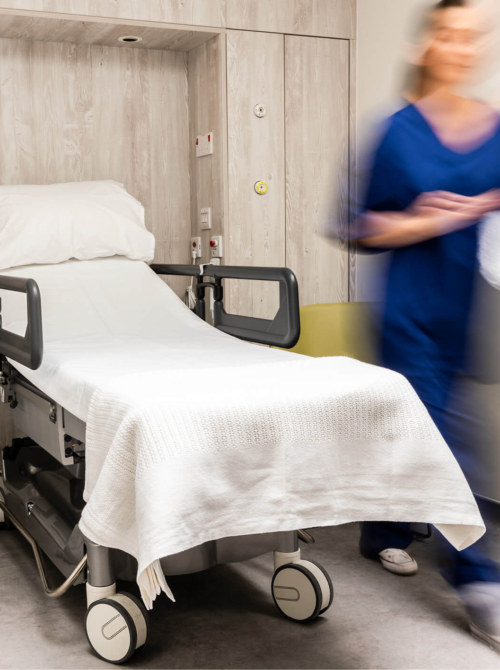Fertility glossary of terms
To help demystify the fertility world, we’ve put together this list of some of the most common fertility terms and their definitions.
Fertility glossary of terms
When you start out on your fertility journey, it can sometimes feel like a crash course in GCSE biology, with a lot of new, and some perhaps familiar, medical terminology. It’s easy to feel a bit overwhelmed at first, so to help you understand the world of conception, we’ve put together this list of some of the most common fertility terms and their definitions.
AMH (Anti-Mullerian Hormone)
AMH is a protein hormone that is produced by the granulosa cells in the small follicles (tiny pouches that contain eggs in the ovary). Granulosa cells are what help to develop eggs in the ovaries of a woman. AMH is given off by these cells in the highest amounts when the follicles are in the preantral and small antral stages of development (less than 4mm in size).
Anovulation
When a woman doesn’t release an egg every month, or sometimes doesn’t ovulate at all. Read more about infertility diagnosis and treatments here.
Assisted Reproductive Technology (ART)
A collective term for fertility treatments.
Artificial insemination
A fertility treatment that involves getting pregnant without having sex. The term usually refers to intrauterine insemination (IUI), a medical procedure where sperm is inserted directly into the womb (uterus) using a long, thin tube.
Assisted Hatching
The procedure in which the outer layer of the embryo is thinned by a laser helps the embryo implant more easily.
Assisted Reproductive Technology
A collective term used to describe fertility treatment.
Basal body temperature (BBT)
Your temperature, taken first thing in the morning when your body is at rest. This helps to give you an accurate reading for each day, as your temperature won’t be raised because of any activity you’ve just been doing. Tracking your BBT daily can help you to work out when you ovulate.
Blastocyst
A term to describe a day five or six embryo. By the fifth or sixth day, the fertilised egg is known as a blastocyst — a rapidly dividing ball of cells. The inner group of cells will become the embryo. The outer group will become the cells that nourish and protect it.
Blighted ovum
When a fertilised egg implants in the womb but sadly doesn’t develop into a baby. Also known as anembryonic pregnancy.
Cervical mucus (CM)
A name for the natural vaginal discharge that all women produce. Cervical mucus changes in colour and texture throughout your menstrual cycle and can help you work out when you’re ovulating.
Cervix
The neck of the womb. The embryo transfer involves passing a small soft catheter through this to allow the embryo to enter the uterus.
Chemical pregnancy
Also known as a missed, silent or delayed miscarriage, chemical miscarriages are usually confirmed by a pregnancy test, but sadly miscarry before the embryo can be seen at an ultrasound scan.
Clomifene or Clomid
The short name for clomifene citrate, a fertility drug that helps to stimulate ovulation. Often used in women with polycystic ovary syndrome (PCOS), and occasionally before assisted conception treatments. Also known by the brand name Clomid.
Curettage – also known as a D&C
Having the contents of the lining of the uterus removed under anaesthetic, either by scraping it with an instrument called a curette or by suctioning it out with a soft plastic tube.
Donor insemination
The technical name for getting pregnant using donated sperm. This option is often taken by women who are in a same-sex relationship, want to have a child by themselves, or whose partners cannot produce sperm. Donor insemination usually involves either IUI or IVF procedures.
Ectopic pregnancy
When a fertilised egg develops outside the womb. An ectopic pregnancy is dangerous for the mother and requires urgent treatment. Sadly, the embryo will not be able to develop into a baby. Most ectopic pregnancies implant in the fallopian tubes, so it’s also known as a tubal pregnancy.
Egg collection
The stage of an IVF treatment cycle where the woman’s eggs are collected under vaginal ultrasound. An ultrasound probe is inserted into your vagina to identify follicles. Then a thin needle is inserted into an ultrasound guide to go through the vagina and into the follicles to retrieve the eggs.
Egg freezing
Also known as fertility preservation, this is a way to harvest and store your eggs, in the hope of using them later. When the time comes, the eggs are thawed and combined with sperm to produce embryos, which are then placed in your womb. This technology is still developing, and there’s no guarantee that you’ll be able to get pregnant later using your eggs. However, healthy babies have been born following a pregnancy resulting from egg freezing.
Embryo
A fertilised egg that has started to develop is known as an embryo until eight weeks of pregnancy, and then a foetus until birth.
Embryo freezing
Embryo freezing, also known as embryo cryopreservation, is similar to egg freezing, except egg and sperm are combined to make an embryo before freezing. This is a much more established technique, and frozen embryos have nearly the same success rates as fresh embryos used in IVF.
Embryo Transfer
The stage of an IVF treatment cycle where the embryo is transferred back to the woman’s uterus via a fine catheter. The doctor will insert a long, thin, flexible tube called a catheter into your vagina, through your cervix and into your uterus. A syringe containing one or more embryos suspended in a small amount of fluid is attached to the end of the catheter. Using the syringe, the doctor places the embryo or embryos into your uterus.
Endometriosis
When the tissue that normally makes up the lining of your womb grows somewhere else in your body, usually on the ovaries or fallopian tubes. About five per cent of women who have trouble conceiving may have issues related to endometriosis.
Endometrium
The membrane lining the inside of the uterus. Just before ovulation, the functional layer of the endometrium goes through specific changes and the endometrial lining becomes thicker and enriched with blood so that it’s ready to receive a fertilised egg and also support a placenta. If conception doesn’t take place after ovulation, the build-up of blood vessels and tissues becomes unnecessary and is shed. This is your period.
Fallopian Tube
The fallopian tube runs from the ovary to the uterus along which the egg normally travels and where the egg and sperm normally join together.
Foetus
The name given to an embryo from eight weeks after fertilisation onwards. At eight weeks, the foetus has developed to such an extent that the body’s major organs (like the brain, liver and kidneys) are able to form. The foetus will continue to be called a foetus until it’s born.
Follicle
A follicle is a sac filled with fluid in which an immature egg develops. Follicles are located in the ovaries. When a follicle grows to an ideal size, ovulation occurs, which results in the rupture of a follicle and the release of an egg from the ovary.
Follicle Stimulating Hormone (FSH)
Follicles are the parts of your ovaries that contain your eggs. FSH causes these follicles to ripen your eggs, ready for release when you ovulate. During IVF, FSH increases the number of eggs your ovaries produce. This means more eggs can be collected and fertilised. With more fertilised eggs, we have a greater choice of embryos to use in your treatment.
Follicular Phase
The first part of a woman’s menstrual cycle, between the first day of the period and the day of ovulation. This is when the body prepares to release an egg, and the lining of the womb gets ready for a possible pregnancy. It usually lasts about two weeks, but can be shorter or longer than this depending on the length of your cycle. The rest of the cycle is known as the luteal phase.
Gamete
A word that describes both the male and female reproductive cells i.e., the sperm and egg.
Gonadotrophins
A type of fertility drug that is used in IVF to stimulate the ovaries to produce more than one follicle. There are various types of gonadotrophins available; brand names include Menopur, Pergoveris, Gonal-F, Metrodin, Pregnyl and Ovitrelle.
hCG
The hormone that is produced by the embryo and is measured in an at-home pregnancy test, and clinical blood tests. Injections of hCG can be used to trigger maturation of the egg which is then followed by ovulation (known as the trigger injection. Injections of hCG may also be used to maintain hormone levels in the second half (luteal phase) of the cycle.
HyCoSy
HyCoSy stands for Hysterosalpingo Contrast Sonography and is a short and very routine procedure to check the fallopian tubes for any blockages or abnormalities. It is sometimes called tubal patency or dye test for fallopian tubes and it involves using a dye to help highlight the area and then an ultrasound scan, as normal looking fallopian tubes can’t be viewed by a standard ultrasound or x-ray in the absence of contrast.
Hysteroscopy
A procedure normally carried out under anaesthetic where the cervix is dilated to allow a small camera to pass through the cervix into the lower end of the uterus to give a clear view of the lining of the uterus. Read more about fertility tests here.
ICSI (Intracytoplasmic Sperm Injection)
ICSI is a procedure used as part of an IVF cycle in which a single sperm is introduced into each egg, by means of micro-injection. ICSI is often recommended for patients with a history of poor fertilisation outcomes following IVF or for male-associated infertility.
Implantation
The embedding of the embryo in the lining of the uterus 6-7 days after fertilisation.
IMSI (Intracytoplasmic Morphologically selected Sperm Injection)
This is the name of the technique where scientists inject selected sperm into an egg to assist fertilisation. IMSI is a modification of the ICSI technique where sperm samples are examined under a microscope that is almost 6000 times more powerful to better assess their “morphology”. At a higher power the embryologist can identify tiny defects in the sperm head that would not otherwise be visible with standard ICSI.
Infertility
You are considered to be infertile if you’ve been trying to conceive for more than a year without success. However, you may still be able to get fertility tests on the NHS if you’ve been trying for more than six months and are over 35. There are many different possible causes of infertility and having trouble conceiving doesn’t mean you’ll never be able to get pregnant. Many couples with fertility issues do go on to have a baby, often with the help of fertility treatments. Read more about fertility investigations here.
Intra-uterine Insemination (IUI)
Treatment that involves inserting the partner’s concentrated semen through the neck of the womb into the uterus itself close to the time of ovulation. Read more about IUI here.
IVF (In Vitro Fertilisation)
IVF, or in-vitro fertilisation, is a procedure in which eggs are fertilised with sperm outside of the body to create embryos which are then transferred back into the womb to implant. IVF is a very successful treatment for many categories of infertility, including Endometriosis, Fibroids, Polycystic Ovaries and for sperm considerations.
Laparoscopy
A procedure that allows doctors to examine your womb, fallopian tubes and ovaries. It can be used to diagnose the cause of infertility and occasionally treat the cause as well. The doctor will insert a camera through your belly button to get a good view. Read more about fertility tests here.
Luteal Phase
The second part of your menstrual cycle, between the day you ovulate and the first day of your period. This is when your womb lining thickens to prepare for a possible pregnancy. It usually lasts about two weeks. The first part of your cycle is known as the follicular phase.
LH (Luteinising Hormone)
This hormone triggers ovulation in women and plays a role in sperm production in men. In women, levels of luteinising hormone peak about 36 hours before ovulation, which is known as the LH surge. Ovulation predictor kits test for this peak in LH.
Miscarriage
A miscarriage is the loss of a pregnancy during the first 23 weeks, however, more than 80% of miscarriages occur during the first 12 weeks of pregnancy. After the first trimester, the miscarriage rate reduces rapidly. Miscarriages are not as uncommon as it might seem – among women who know they’re pregnant, it’s estimated about 1 in 8 pregnancies end in miscarriage, however, most of them occur due to chromosomal abnormalities.
Morphology
Sperm morphology — the size and shape of sperm — is one factor that’s examined as part of a semen analysis to evaluate male infertility. Sperm morphology results are reported as the percentage of sperm that appear normal when semen is viewed under a microscope.
Motility
Sperm motility describes the ability of sperm to move properly through the female reproductive tract (internal fertilisation) or through water (external fertilisation) to reach the egg. Sperm motility can also be thought of as the quality, which is a factor in successful conception; sperm that do not “swim” properly will not reach the egg in order to fertilise it.
Oestrogen
The primary female hormone, produced mainly from the ovary from puberty until menopause.
Oocyte
The fully mature egg, produced from the ovary each month.
Ovarian Hyperstimulation Syndrome (OHSS)
OHSS is a condition that happens when fertility drugs cause too many eggs to develop at once in your ovaries. This can cause swelling, discomfort and nausea. In most cases, OHSS is mild, and can be monitored at home. But more severe cases may require a hospital stay, and you may have to stop taking fertility drugs for a while.
Ovaries
The ovaries produce and release eggs (oocytes) into the female reproductive tract at the mid-point of each menstrual cycle. They also produce the female hormones oestrogen and progesterone.
Ovulation
The time in your cycle when one or more eggs are released from one of your ovaries. This usually happens around the middle of the cycle, about day 14 in an average 28-day cycle. You’re at your most fertile the couple of days just before you ovulate, and the day of ovulation itself.
Ovulation Induction
Medication used to stimulate growth and release of the eggs. This may be used in combination with IUI.
Pelvic inflammatory disease (PID)
An infection that can affect your womb, ovaries and fallopian tubes. About one in five women with pelvic inflammatory disease have trouble conceiving.
Polycystic ovarian syndrome (PCOS)
Polycystic ovary syndrome (PCOS) is one of the most frequent causes of female infertility. Also known as polycystic ovarian syndrome, the condition affects how a woman’s ovaries function and in turn influences a woman’s fertility. The polycystic ovaries contain a large sum of tiny cysts triggered by an imbalance of reproductive hormones. These harmless follicles are identified as underdeveloped sacs where eggs develop; up to 8mm in size. PCOS prevents the sacs from releasing eggs; subsequently preventing ovulation. Although there is no cure for PCOS the health condition is treatable leading to an increased chance of conceiving.
Pre-implantation genetic diagnosis (PGD)
If you or your partner have a genetic condition that you could pass to your baby, or if there’s a history of a particular condition in either of your families, you may be eligible for pre-implantation genetic diagnosis. This is a form of IVF where any embryos are tested for genetic disorders, and only implanted if they are unaffected.
Pre-implantation Genetic Testing for Aneuploidy (PGT-A)
PGT-A (also known as PGS) is a procedure used as part of an IVF cycle, with or without ICSI, in which each embryo is screened to determine whether it is chromosomally normal. A major reason why IVF fails, is as result of chromosomal abnormalities within the embryo. If chromosomes are not present in the correct configuration, an embryo cannot result in a healthy pregnancy.
Progesterone
The hormone produced by the ovary after ovulation to maintain the pregnancy. You will be prescribed progesterone as part of an IVF cycle to support pregnancy in the first trimester.
Semen
The ejaculated fluid comprising of sperm and other secretions of the sex glands of the male.
Spermatozoa / sperm
The male reproductive cells.
Ultrasound
A modified form of radar used to see the follicles in the ovary and pregnancy in the uterus. This may be done either through the abdomen or (more usual in IVF) through the vagina.
Uterus (aka Womb)
The uterus is a hollow muscular organ located in the female pelvis between the bladder and rectum. The ovaries produce eggs that travel through the fallopian tubes. Once the egg has left the ovary it can be fertilised and implant itself in the lining of the uterus. The main function of the uterus is to nourish the developing foetus prior to birth.
Vas Deferens
The tube that transports the sperm from the testes. The vas deferens, is a fibromuscular tube that is the continuation of the epididymis and is an excretory duct of the testis and serves to transport sperm cells to the ejaculatory duct.
Vasectomy
A form of contraception for men where the vas deferens (the tube along which the sperm passes) is tied off or clipped.
Vitrification
Vitrification is the process of removing water from a blastocyst in an ultra-rapid manner. The cooling rates are over -1,200 degrees C/min, which reduces the presence of ice crystals inside the cells, and increases the survival and pregnancy potential of the blastocyst, as compared to previous slow-freeze methods.





